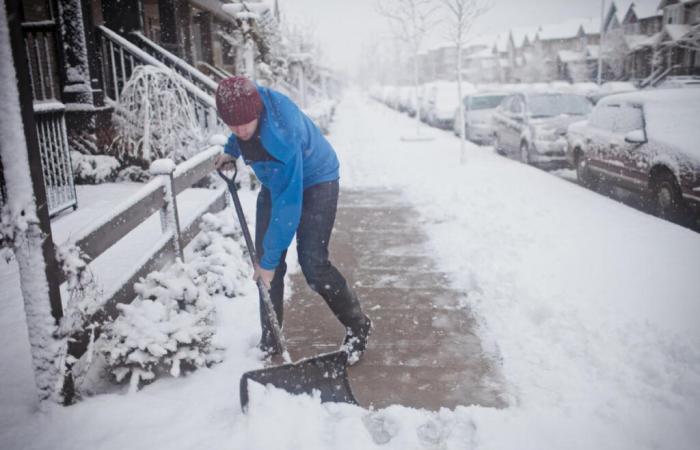Winter is coming and, with it, snow, ice, bitterly cold temperatures and biting winds. Winter weather —including low temperatures and storms — involves a number of risks, from frostbite and hypothermia to power outages and dangerous driving conditions. “The biggest thing is to be prepared,” Catie Ballenger, a national spokesperson for the American Red Cross, tells Yahoo Life. “It’s not a cliché; it’s what you need to do to take care of yourself and your family.”
Here’s how to plan ahead for winter weather — from what to expect this season to expert tips for staying safe (and warm!).
Winter weather can be dangerous — even in the warmer South
Anything could happen, but the National Oceanic and Atmospheric Administration (NOAA) is predicting a warmer, drier winter in the southern half of the U.S., with wetter than usual weather in northern parts of the country. But, every year, different types of winter weather affect each region, experts say. Blizzard conditions can strike the Mountain West and parts of the Midwest, downpours of rain can bring mudslides to California and ice storms can disrupt the Great Plains and mid-Atlantic states. On the East Coast, Nor’easters that dump heavy, wet snow may down power lines and tree branches.
Even though climate change is causing warmer temperatures year-round, it’s also leading to more unpredictable and extreme winter weather — especially in parts of the country not accustomed to heavy snow. That’s what happened in Texas in 2021, when historic winter storms left 246 people dead and overwhelmed the state’s power grid, causing rolling blackouts for more than two weeks and cutting off power to millions. “People up North like to make fun of places down South when they freak out because of 2 inches of snow, but it’s a big deal down there,” Nick Bassill, a University at Albany adjunct professor and director of the State Weather Risk Communication Center in New York, tells Yahoo Life. So, even if you’re not in a Northern state, it’s wise to be ready for whatever winter may bring.
How winter weather can sneak up on you — and what to do
The biggest health risks posed by freezing temperatures and windchill are frostbite and hypothermia, and they can happen quickly, says Ballenger. “When people think of frostbite, they think of a change in skin color, but they need to be looking for numbness and pain in the extremities, [like] the fingers, toes, nose, ears and cheeks,” she says. If you notice signs of frostbite, get somewhere warm immediately, and run the affected body parts under warm — not hot — water, Mike Muccilli, acting winter program manager at NOAA, tells Yahoo Life. If you’re still numb after rewarming yourself, you should go to the emergency room, according to the Cleveland Clinic.
Hypothermia — when the body gets dangerously cold — can happen even when you don’t feel cold, such as while you’re working up a sweat shoveling snow. If you start to feel sleepy or confused, it’s a good time to go inside and warm up. Be especially careful to take breaks while shoveling heavy, wet snow (the type that often strikes the Northeast), which can trigger heart attacks.
Whatever you’re doing outside in the winter, be sure to dress yourself and your kids in several light layers. Ballenger suggests wearing a long-sleeved shirt and a sweatshirt or sweater under your coat. “This keeps things more regulated,” she says. Warm boots, a hat, gloves and scarves are also key to covering and insulating the body.
Prep your home for the worst winter can bring
Power outages are common amid cold weather and winter storms, and cars often get into accidents or get stranded. A good first step in your preparations, Ballenger says, is to follow your county, local sheriff and local emergency management offices on social media. The Red Cross also has an app, and any of these resources will provide information about where warming shelters — temporary facilities equipped with heat, beds and often food — are located. These and NOAA weather radio stations also provide information about what kind of weather is expected and guidance about precautions to take.
But if roads are already icy or snow-covered by the time you lose power, it’s not safe to drive to a shelter. More than 1,300 people die in car accidents involving snowy, icy or slushy roads each year, and another 116,800 are injured, according to the U.S. Department of Transportation. So your best bet is to stay put, and experts advise keeping supplies on hand at your home. “We recommend putting together a home emergency kit with adequate clothing and blankets so, if you lose power, you’re able to stay warm,” says Muccilli.
Experts recommend having:
-
At least three days’ worth of medications
-
At least three days’ worth of ready-to-eat, nonperishable food
-
A gallon of drinking water per person for each of three days
-
NOAA weather radio to hear broadcasts from the nearest National Weather Service station (you can buy battery-powered, hand-crank or solar-powered radios, or download the iPhone or Android apps)
-
Flashlights and extra batteries
-
Cellphone charger with, if possible, a rechargeable backup battery
If your power does go out, you can take steps to keep your home warm, experts say. Draw your curtains, and consider covering your windows and gaps under doors with towels or blankets. Close the doors to any rooms you don’t absolutely need to go into, and bring your whole family to one room — ideally in the center of the home, away from windows — with blankets and warm clothes on so you can conserve heat there and share body heat. Keep your refrigerator closed, too, to keep cold air inside to preserve food for as long as possible.
Do not, under any circumstances, light fires outside fireplaces, or try to heat the home with the warmth of the oven, experts warn. This poses severe risks, respectively, of house fires and carbon monoxide poisoning, and rates of both spike every winter. If you do use a space heater, make sure you keep it at least 3 feet away from any other objects, and in a place where it’s not likely to be knocked over.
Get your car ready for winter storms
First and foremost, experts agree that you should avoid driving in ice and snow at all, if possible. But, if you must get on the road, Muccilli advises getting snow tires or adding chains to your tires to improve their traction if you live in an area prone to snow. Unfortunately, neither does much against pure ice on the roads.
You should also stock your car with supplies to stay warm and safe if you get stuck. If you’re stranded, “There’s no guarantee that you’re going to be the first one that first responders get to,” says Ballenger. “Your plan should be to be able to take care of yourself … so you know you’re going to be absolutely OK if it takes a little while to get a tow truck.”
Consider packing a car kit including:
-
Flashlights and batteries
-
Non-perishable snacks, such as PowerBars
-
A small shovel and cat litter, sand or rock salt to dig yourself out of snow if necessary
-
Ice scraper to clear your windshield
-
A red ribbon or something colorful to tie to your antenna to make your car easier to spot if you have to pull over in low-visibility conditions






